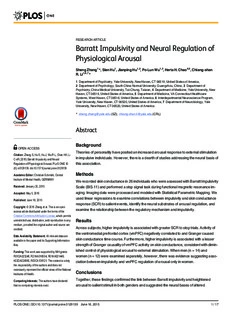
Barratt Impulsivity and Neural Regulation of Physiological Arousal PDF
Preview Barratt Impulsivity and Neural Regulation of Physiological Arousal
RESEARCHARTICLE Barratt Impulsivity and Neural Regulation of Physiological Arousal ShengZhang1*,SienHu1,JianpingHu1,2,Po-LunWu1,3,HertaH.Chao4,5,Chiang-shan R.Li1,6,7* 1 DepartmentofPsychiatry,YaleUniversity,NewHaven,CT06519,UnitedStatesofAmerica, 2 DepartmentofPsychology,SouthChinaNormalUniversity,Guangzhou,China,3 Departmentof Psychiatry,ChinaMedicalUniversity,Tai-Chung,Taiwan,4 DepartmentofMedicine,YaleUniversity,New Haven,CT06519,UnitedStatesofAmerica,5 DepartmentofMedicine,VAConnecticutHealthcare Systems,WestHaven,CT06516,UnitedStatesofAmerica,6 InterdepartmentalNeuroscienceProgram, YaleUniversity,NewHaven,CT06520,UnitedStatesofAmerica,7 DepartmentofNeurobiology,Yale University,NewHaven,CT06520,UnitedStatesofAmerica * [email protected](SZ); [email protected](CRL) Abstract Background OPENACCESS Theoriesofpersonalityhavepositedanincreasedarousalresponsetoexternalstimulation Citation:ZhangS,HuS,HuJ,WuP-L,ChaoHH,Li inimpulsiveindividuals.However,thereisadearthofstudiesaddressingtheneuralbasisof C-sR(2015)BarrattImpulsivityandNeural RegulationofPhysiologicalArousal.PLoSONE10 thisassociation. (6):e0129139.doi:10.1371/journal.pone.0129139 Methods AcademicEditor:ChristianSchmahl,Central InstituteofMentalHealth,GERMANY Werecordedskinconductancein26individualswhowereassessedwithBarrattImpulsivity Received:January20,2015 Scale(BIS-11)andperformedastopsignaltaskduringfunctionalmagneticresonanceim- Accepted:May5,2015 aging.ImagingdatawereprocessedandmodeledwithStatisticalParametricMapping.We usedlinearregressionstoexaminecorrelationsbetweenimpulsivityandskinconductance Published:June16,2015 response(SCR)tosalientevents,identifytheneuralsubstratesofarousalregulation,and Copyright:©2015Zhangetal.Thisisanopen examinetherelationshipbetweentheregulatorymechanismandimpulsivity. accessarticledistributedunderthetermsofthe CreativeCommonsAttributionLicense,whichpermits unrestricteduse,distribution,andreproductioninany Results medium,providedtheoriginalauthorandsourceare Acrosssubjects,higherimpulsivityisassociatedwithgreaterSCRtostoptrials.Activityof credited. theventromedialprefrontalcortex(vmPFC)negativelycorrelatedtoandGrangercaused DataAvailabilityStatement:Allrelevantdataare skinconductancetimecourse.Furthermore,higherimpulsivityisassociatedwithalesser availableinthepaperanditsSupportingInformation files. strengthofGrangercausalityofvmPFCactivityonskinconductance,consistentwithdimin- ishedcontrolofphysiologicalarousaltoexternalstimulation.Whenmen(n=14)and Funding:ThisworkwassupportedbyNIHgrants R01DA023248,R21AA018004,R01AA021449, women(n=12)wereexaminedseparately,however,therewasevidencesuggestingasso- K02DA026990,R03CA138121.Thecontentissolely ciationbetweenimpulsivityandvmPFCregulationofarousalonlyinwomen. theresponsibilityoftheauthorsanddoesnot necessarilyrepresenttheofficialviewsoftheNational Conclusions InstitutesofHealth. Together,thesefindingsconfirmedthelinkbetweenBarrattimpulsivityandheightened CompetingInterests:Theauthorshavedeclared thatnocompetinginterestsexist. arousaltosalientstimuliinbothgendersandsuggestedtheneuralbasesofaltered PLOSONE|DOI:10.1371/journal.pone.0129139 June16,2015 1/17 ImpulsivityandArousal regulationofarousalinimpulsivewomen.Moreresearchisneededtoexploretheneural processesofarousalregulationinimpulsiveindividualsandinclinicalconditionsthatimpli- catepoorimpulsecontrol. Introduction Characterizedbybehavioraldisinhibitionandrashactions,traitimpulsivitymaydisposeindi- vidualstonegativeconsequences.Animportantdimensionoftraitimpulsivityconcernsthe regulationofphysiologicalarousal.Anumberofleadingtheoriesofpersonalitypositthatim- pulsivity–asacomponenttraitofextraversion–ischaracterizedbyunder-arousalatrestand greaterincreasesinarousalinresponsetostimulation[1–5].Impulsiveindividualsseek stimulationtomaintainanoptimallevelofarousal. Insupport,manystudiesdemonstratedincreasedphysiologicalarousaltostimulationinin- dividualshigheronimpulsivity.Forinstance,impulsivityinassociationwithrisktakingbehav- iorwascorrelatedtoincreasedskinconductancereactivitytoarousingstimuli[6].Impulsivity wasassociatedwithincreasedheartratetoanauditoryattentiontaskinmen[7].Indomestic violenceoffenders,traitimpulsivitywasassociatedwithincreasedskinconductanceresponse (SCR)duringapreparatoryperiodtoconfrontstress[8].Inadouble-blindstudyofindividual differencesinacutesubjectiveresponsestoamphetamine,hightraitimpulsivitywassignifi- cantlyassociatedwithgreaterarousalandeuphoria[9].Gamblersshowedincreasedheartrate duringthegame,inpositivecorrelationwithsubjectivereportofarousalandsensationseeking [10].Frequentgamblerswerefoundtohavesignificantlyhigherlevelsofarousal,whichcontin- uetoriseafterplay,incontrasttoinfrequentandnon-gamblers[11].InchildrenwithADHD performingadelayedreactiontimetask,rewardevokedhigherSCRandledtomoreimpulsive responses,ascomparedtocontrolparticipants[12].Highimpulsivemenexhibitedslower heartrateunderrestalongwithgreaterreactivitytoabehavioralchallenge[7].Alsoinsupport ofthehypothesisarestudiesreportingincreasedorientingERPsduringsensorystimulationin impulsiveindividuals[13,14]. Ontheotherhand,nostudiestoourknowledgehaveexaminedtheneuralbasesofarousal regulationinassociationwithimpulsivity.Here,weaddressedthisissuebystudying26healthy adultsinastopsignaltaskincombinationwithfunctionalmagneticresonanceimaging(fMRI) andconcurrentrecordingofskinconductance.First,weexaminedwhetherimpulsivity,asas- sessedbyBarrattImpulsivityScale(BIS-11),isassociatedwithskinconductancelevel(SCL) andSCRtoinfrequent,salientevents.Second,ourpreviousfMRIstudydemonstratedthatthe timecourseoftheventromedialprefrontalcortex(vmPFC)isnegativelycorrelatedwithSCL andthestrengthofGrangercausalityofvmPFConSCLisnegativelycorrelatedwithSCRtosa- lientstimuli,suggestingaprefrontalcorticalmechanismofarousalregulation[15].Oursecond aimwastoexaminehowinter-subjectvariationinimpulsivityrelatestovmPFCregulationof skinconductance.Third,thereisevidenceforgenderdifferenceintheassociationbetween traitimpulsivityandriskybehavior[16–20].Thus,weexaminedwhethertheassociationbe- tweenimpulsivityandphysiologicalarousalaswellastheneuralbasisofarousalregulation variesbetweenmenandwomen. MaterialsandMethods Subjects,behavioraltask,andBarrattImpulsivityScale Twenty-sixadulthealthysubjects(14males,18–52yearsofage,allright-handedandusing theirrighthandtorespond)participatedinthisstudy(Table1).Thissamplecomprised20of the24participantsreportedinourpreviouswork(Zhangetal.,2014;theother4werenot PLOSONE|DOI:10.1371/journal.pone.0129139 June16,2015 2/17 ImpulsivityandArousal Table1. Demographicsofthesubjects. Subjectcharacteristic All(n=26) Male(n=14) Female(n=12) p-value Ages(years) 30.6±10.3 31.1±11.2 29.9±9.5 0.78* Race(EA/AA/Others) 21/3/2 12/1/1 9/2/1 0.74^ Education(years) 16.6±3.2 16.5±3.9 16.8±1.9 0.77* Note:valuesaremean±S.D.;p-valuesarefromstatisticcomparisonbetweenmalesandfemales *two-tailedtwo-samplettest ^chi-squaretest doi:10.1371/journal.pone.0129139.t001 assessedforimpulsivityandthusnotincluded)and6newsubjects,allstudiedunderanidenti- calprotocol.Allparticipantsdeniedmedicalincludingneurologicalillnesses,historyofhead injuries,currentuseofanymedications,oruseofanypsychotropicmedicationsinthepast year.TheywerealsofreeofanypsychiatricdiagnosesasassessedwiththeStructuredClinical InterviewforDiagnosticandStatisticalManualDisorders[21],denieduseofillicitsubstances, andshowedanegativeurinetoxicologytestonthedayoffMRI.Allsubjectswerepaidtopar- ticipateandsignedawrittenconsentafterdetailsofthestudywereexplained,inaccordanceto aprotocolapprovedbytheYaleHumanInvestigationCommittee. Weemployedasimplereactiontime(RT)taskinthisstop-signalparadigm,asdescribedin detailspreviously[22–24].Briefly,thereweretwotrialtypes:“go”(~75%)and“stop”(~25%), randomlyintermixed.Asmalldotappearedonthescreentoengageattentionatthebeginning ofagotrial.Afterarandomizedtimeinterval(fore-period)between1and5s,thedotturned intoacircle,promptingthesubjectstoquicklypressabutton.Thecirclevanishedatbutton pressorafter1shadelapsed,whichevercamefirst,andthetrialterminated.Aprematurebut- tonpresspriortotheappearanceofthecirclealsoterminatedthetrial.Inastoptrial,an“X,” the“stop”signal,appearedandreplacedthegosignal,instructingthesubjectstowithholdbut- tonpress.Likewise,atrialterminatedatbuttonpressorafter1shadelapsed.Therewasan inter-trial-intervalof8stoallowadequatespacingbetweeneventsofinterestandidentification ofelectrodermalresponsesassociatedwiththeseevents.Thetimeintervalbetweengoandstop signalsorstopsignaldelay(SSD)startedat200msandvariedfromonestoptrialtothenext accordingtoastaircaseprocedure,increasinganddecreasingby64ms,eachafterasuccessful andfailedstoptrial[25,26].Withthestaircaseprocedure,a“critical”SSDcouldbecomputed thatrepresentsthetimedelayrequiredforthesubjecttosucceedinhalfofthestoptrials[25]. ThestopsignalreactiontimewascomputedbysubtractingthecriticalSSDfrommediango RT.Subjectswereinstructedtorespondtothegosignalquicklywhilekeepinginmindthata stopsignalcouldcomeupinasmallnumberoftrials[27].Withthestaircaseprocedurewean- ticipatedthatthesubjectswouldsucceedinwithholdingtheirresponseinapproximatelyhalf ofthestoptrials.Afterapracticesessionoutsidethescanner,eachsubjectcompletedsix 10-minrunsofthetaskinthescanner. IndividualimpulsivitywasquantifiedfromthetotalscoreontheBarrattImpulsiveness Scale,version11orBIS-11[28,29].ThreesubscoresoftheBIS-11werealsocomputedfor“at- tentionalimpulsivity”oraninabilitytofocus,“motorimpulsivity”oractingwithoutprior thought,and“nonplanningimpulsivity”ornotthinkingandplanningcarefully[29].Eachsub- scalecomprises10questionswithsomeitemstobereverse-scoredtocontrolforresponsebias. TheBIS-11iswidelyusedinpersonalityandclinicalresearchtocaptureindividualtendency towardrashandriskbehaviors.TheBISsubscoresaremissingforamalesubject.Thus,inthe followinganalysis,only25subjectswereusedforsubscoresrelatedanalysis. PLOSONE|DOI:10.1371/journal.pone.0129139 June16,2015 3/17 ImpulsivityandArousal Skinconductanceacquisitionandanalysis WithaBiopacMP150system,skinconductancewascontinuouslyrecordedduringfMRIfrom thepalmersurfacesoftheindexandmiddlefingersofthelefthand.TheBiopacsystemuseda AcqKnowledge4.1software(BiopacSystems,USA)andtheBiopacelectrodermalactivityam- plifiermodule(GalvanicSkinResponse[GSR]100c)setatachannelsamplingrateof31Hz andagainof5μSiemens(μS)pervolt(resultinginaresolutionof0.0015μS).Recordingof skinconductanceissynchronizedwithbehavioraltaskandimageacquisition.Asmoothing functionwithamovingaverageof500mswasappliedinordertoeliminatehigh-frequency noise[30].TheSCLwascomputedbyresamplingtheskinconductancewaveformtomatch theTR(2s)usedinfunctionalimagingdataacquisitionandanalysis[31,32].Becauseeachin- dividualtriallastedlongerthan10s,weuseda10-swindowalignedwithgosignalonsetto computetheSCRforeachtrial.TheSCRwascomputedastheonset-to-peakamplitudediffer- enceinskinconductanceinthis10-swindowasinapreviousstudy[33]. Skinconductanceresponse:impulsivityandgenderdifferences Wecomputedtheskinconductanceresponses(SCR)togo(G),stopsuccess(SS),andstop error(SE)trials.Inananalysisofvarianceweexaminedthemaineffectsoftrialtypeandgen- derandtheirinteractioneffectonthemagnitudeofSCR,followedbyplannedcomparisons. WithPearsonregressionsweexaminedthecorrelationbetweeneachSCRandBIS-11total scoreformenandwomencombinedaswellasseparately.Incaseswheretheresultswerestatis- ticallysignificant,were-examinedthecorrelationofSCRtotheattention,motor,andnonplan- ningsubscoresofBIS-11. Imagingprotocolanddatapreprocessing ConventionalT1-weightedspinechosagittalanatomicalimageswereacquiredforslicelocali- zationusinga3Tscanner(SiemensTrio).Anatomicalimagesofthefunctionalslicelocations werenextobtainedwithspinechoimagingintheaxialplaneparalleltotheanteriorcommis- sure–posteriorcommissure(AC–PC)linewithTR=300ms,TE=2.5ms,bandwidth=300 Hz/pixel,flipangle=60°,fieldofview=220×220mm,matrix=256×256,32sliceswithslice thickness=4mmandnogap.Functional,bloodoxygenationlevel-dependent(BOLD)signals werethenacquiredwithasingle-shotgradientechoechoplanarimaging(EPI)sequence.Thir- ty-twoaxialslicesparalleltotheAC–PClinecoveringthewholebrainwereacquiredwith TR=2000ms,TE=25ms,bandwidth=2004Hz/pixel,flipangle=85°,fieldof view=220×220mm,matrix=64×64,32sliceswithslicethickness=4mmandnogap. BrainimagingdatawerepreprocessedusingStatisticalParametricMappingversion8 (WellcomeDepartmentofImagingNeuroscience,UniversityCollegeLondon,U.K.).Images fromthefirstfiveTRsatthebeginningofeachsession/runwerediscardedtoenablethesignal toachievesteady-stateequilibriumbetweenradiofrequencypulsingandrelaxation.Imagesof eachindividualsubjectwerefirstcorrectedforslicetimingandrealigned(motioncorrected).A meanfunctionalimagevolumewasconstructedforeachsubjectforeachrunfromthere- alignedimagevolumes.ThesemeanimageswerenormalizedtoanMNI(MontrealNeurologi- calInstitute)EPItemplatewithaffineregistrationfollowedbynonlineartransformation[34]. Thenormalizationparametersdeterminedforthemeanfunctionalvolumewerethenapplied tothecorrespondingfunctionalimagevolumesforeachsubject.Finally,imageswere smoothedwithaGaussiankernelof8mmatFullWidthatHalfMaximum. AdditionalpreprocessingwasappliedtoreducespuriousBOLDvariancesthatwereunlikely toreflectneuronalactivity[35,36].Thesourcesofspuriousvariancewereremovedthrough linearregressionbyincludingthesignalfromtheventricularsystem,thewhitematter,andthe PLOSONE|DOI:10.1371/journal.pone.0129139 June16,2015 4/17 ImpulsivityandArousal wholebrain,inadditiontothesixparametersobtainedbyrigidbodyheadmotioncorrection. First-orderderivativesofthewholebrain,ventricularandwhitemattersignalswerealsoin- cludedintheregression. Voxelwiselinearcorrelationwithskinconductance Wecomputedforindividualsubjectsthecorrelationcoefficientbetweentheskinconductance level(SCL)andthetimecoursesofeachvoxelforthewholebrain.Notethattheskinconduc- tanceimpulseresponsefunctionisverycloseinshapeandlatencytothatofthecanonicalhemo- dynamicresponsefunction[31,37].Thus,SCLcouldbecrosscorrelatedwithBOLDsignals withoutadditionalprocessing.Wethenconvertedtheseindividualcorrelationmaps,whichwere notnormallydistributed,tozscoremapsbyFisher’sztransform:z=0.5loge[(1+r)/(1−r)].Thez mapswereusedinthesecondlevelrandomeffectsanalysis[38].Aone-samplet-testwasapplied tothe‘zmaps’acrossallsubjectstoidentifyregionalactivitiescorrelatedtoskinconductance. Functionalregionsofinterest(ROIs)weredefinedbasedonactivatedclustersatacorrected thresholdfromwhole-brainanalysis.AllvoxelactivationswerepresentedinMNIcoordinates. GrangercausalityanalysisofbrainactivityandSCLtimecourse BOLDandskinconductancesignalswereexaminedwithGrangercausalityanalysis(GCA, [39]),whichhasbeenwidelyusedtodescribe“causal”influencebetweensetsofEEGorfMRI timeseries[40–46],asdescribedindetailsinourpreviousstudies[47–49].Briefly,weused multivariateautoregressive(MAR)modeling[46,50]toperformGCA.Inanunrestricted modelofthetimeseries Xp YðtÞ¼ AYðt(cid:2)iÞþεðtÞ;t ¼1;2;...;T; ð1Þ i i¼1 Y(t)isacolumnvector[y1(t),y2(t),...,yn(t)]inwhicheachelementyj(t),j=1,2,...,n,istheav- eragetimeseriesofaregionofinterest(ROI)orSCLattimepointt;Tisthenumberoftime points;nisthenumberofROI/SCL;andε(t)isacolumnvector[ε1(t),ε2(t),...,εn(t)]ofresid- ualsattimepointt.ThemodelorderisrepresentedbypandAiisan-by-nmatrixgivenby 2 3 aðiÞ aðiÞ (cid:3)(cid:3)(cid:3) aðiÞ 6 11 12 1n7 66aðiÞ aðiÞ (cid:3)(cid:3)(cid:3) aðiÞ77 Ai ¼666 ...21 ...22 ... ...2n777;i¼1;2;...;p; ð2Þ 4 5 aðiÞ aðiÞ (cid:3)(cid:3)(cid:3) aðiÞ n1 n2 nn estimatedbyordinaryleastsquares[51].Todeterminethemodelorder,weemployedthe BayesianInformationCriterion[52,53].TheapplicationofMARmodelingrequiredthat eachROIorSCLwascovariancestationary,whichweexaminedwiththeAugmented DickeyFuller(ADF)test[54].TheADFtestverifiedthattherewasnounitrootinthe modeledtimeseries.TotestwhethervariablexGrangercausesy,wherex,y2Y(t),x6¼y, wecomputedtheregressionEq(1)withoutvariablex(therestrictedmodel)andobtained theresiXdualsumofsquaresRSSXrofvariabley.Theresidualsumofsquaresofyisgivenby RSS¼ T ðyðtÞ(cid:2)^yðtÞÞ2 ¼ T εðtÞ2,wherey^representsthepredictedvalueofy.These t¼1 t¼1 residualswereusedtocomputetheGrangercausalitystrengthmeasures(F-values)ofeach PLOSONE|DOI:10.1371/journal.pone.0129139 June16,2015 5/17 ImpulsivityandArousal possibleconnectionbetweenROIsandskinconductance[54]: ðRSSr(cid:2)RSSurÞ= F ¼ p; ð3Þ RSSur= ðT(cid:2)2p(cid:2)1Þ whereRSSuristheresidualsumofsquaresofvariableyintheunrestrictedmodel.Wetested thesignificanceoftheGrangercausalitybetweentimeseriesbyanFtestandusedbinomialtest toassessstatisticalsignificanceingroupanalysisasdescribedindetailsearlier[47–49].For eachconnection,wecountedthenumberofsubjectsthathadsignificantconnectionsandesti- mateditssignificanceusingabinomialdistributionwithparametersn=26,andp=q=0.5 (sameprobabilitytoobserveaconnectionornot).Foreachsubject,wehadatotalof1770(295 x6)timepointsforGrangercausalityanalysis. ToassesshowthestrengthofGrangercausalityrelatestoevent-evokedarousal,weexam- inedthecorrelationacrosssubjectsbetweenthecausalitystrengthmeasures(F-values)and stimulus-evokedSCRwithalinearregression. Impulsivityandventromedialprefrontalcorticalregulationofskin conductance Asdescribedabove,ourearlierworkwithGCAsuggestedaregulatoryroleoftheventromedial prefrontalcortex(vmPFC)onskinconductance[15].ThestrengthofGrangercausalitywasin- verselycorrelatedwiththeSCRtostoptrials.Thus,here,weexaminedwhetherthisGranger causalityiscorrelatedtoBIS-11totalscoreinmenandwomencombinedandseparately. Results Impulsivity,behavioralperformanceandskinconductanceresponse Acrosssubjects,BIS-11totalscoresrangedfrom42to85withamean±S.D.of60.2±11.9.In pairwisecorrelation,thesubscalescoresshowedacorrelationbetweenattentionandmotorim- pulsivity(p=0.00007),betweenattentionandnon-planningimpulsivity(p=0.003),butnot betweenmotorandnon-planningimpulsivity(p=0.06).Menandwomendidnotdifferinei- thertotal(men:63±12;women56±12)orsubscalescores(allp’s>0.14). Acrosssubjects,participantsrespondedin97.8%±3.5%ofgotrialsand55.0%±2.9%of stoptrials.Theaverageresponsetimeofstoperrortrials(606±92ms)wasshorterthanthego responsetrials(669±67ms,p<0.00001,pairedsamplettest).Thestopsignalreactiontime (SSRT)was236±32msacrosssubjects.Theseresultsaretypicalofstopsignaltaskperfor- mance.MenandwomendidnotshowadifferenceinSSRT(p=0.29)norwasthereacorrela- tionbetweenBIS-11totalscoreandSSRTinmenandwomencombined(p=0.62)orinman (p=0.20)orwomen(p=0.29)alone[55]. Skinconductanceresponses(SCR)duringtheSSTareshowninFig1.Asdescribedinthe Methods,wequantifiedtheSCRbysubtractingtheamplitudeatthebaselinefromtheampli- tudeatthepeakina10-secondwindowafterstimulusonsetforeachtrial.Acrossall26sub- jects,go(G),stopsuccess(SS)andstoperror(SE)trialsshowedsignificantdifferencesinSCR (p=0.002,trialmaineffect,two-wayANOVA),asdidplannedcomparisons:Gvs.SS (p=0.02),Gvs.SE(p=0.0002),andSSvs.SE(p=0.0002),withtwo-samplettests.Therewas alsoagendermaineffectwithmenshowinggreaterSCRthanwomen(p=0.009)butnointer- actioneffectbetweentrialandgender(p=0.54). PLOSONE|DOI:10.1371/journal.pone.0129139 June16,2015 6/17 ImpulsivityandArousal Fig1.SkinconductanceresponsesintheSST.Skinconductanceresponses(SCR)togo(G),stop success(SS)andstoperror(SE)trialsintheSST.DatabarsshowSCR(mean±S.E.)formen(n=14)and women(n=12)separately.Acrossall26subjects,G,SSandSEtrialsshowedsignificantdifferencesinSCR (p=0.002,trialmaineffect,two-wayANOVA),asdidplannedcomparisons:Gvs.SS(p=0.02),Gvs.SE (p=0.0002),andSSvs.SE(p=0.0002),withtwo-samplettests.Therewasalsoagendermaineffectwith menshowinggreaterSCRthanwomen(p=0.009)butnointeractioneffectbetweentrialandgender (p=0.54). doi:10.1371/journal.pone.0129139.g001 Impulsivityandskinconductanceresponse Acrosssubjects,BIS-11totalscorecorrelatedpositivelywithSCRtoSSandSEbutnotGtrials (Fig2).Inregressionsconductedseparatelyformenandwomen,onlywomendemonstrated significantcorrelationsbetweenBIS-11andSCRtoSSandSEtrials(Fig2). WefurtherexaminedthecorrelationbetweenBIS-11subscoresandSCR.Theresults showedthatSCRisrelatedtoattentionalandmotorbutnotnonplanningimpulsivityin womenandSCRisnotsignificantlycorrelatedtoanyofthesubscoresinmen(Table2). ArousalrelatedbrainactivationandGrangercausalityanalysis(GCA) Asexpected,weobservedthattheventromedialprefrontalcortex(vmPFC,x=2,y=25,z= -14)showedsignificant(peakvoxelp<0.001andclusterlevelp<0.05,FWEcorrected)nega- tivecorrelationwithskinconductance(Fig3). Fig2.CorrelationbetweenBIS-11totalscoreandSCR.CorrelationbetweenBIS-11totalscoreandSCRto(a)G,(b)SS,and(c)SEtrialsacrossall26 subjects(black)aswellasacross14men(green)and12women(red)separately. doi:10.1371/journal.pone.0129139.g002 PLOSONE|DOI:10.1371/journal.pone.0129139 June16,2015 7/17 ImpulsivityandArousal Table2. AsummaryofcorrelationsbetweenBIS-11subscores(Attention,Motor,andNonplanning Impulsiveness)andSCR. Attention Motor Nonplanning p r p r p r Allsubjects: SCRofG 0.06 0.38 0.08 0.35 0.86 0.04 SCRofSS 0.006 0.54 0.01 0.51 0.27 0.23 SCRofSE 0.01 0.49 0.002 0.59 0.30 0.21 Men: SCRofG 0.34 0.28 0.65 0.13 0.62 0.14 SCRofSS 0.13 0.42 0.28 0.31 0.24 0.34 SCRofSE 0.25 0.33 0.18 0.38 0.27 0.31 Women: SCRofG 0.26 0.37 0.02 0.67 0.87 -0.06 SCRofSS 0.04 0.63 0.004 0.79 0.61 0.17 SCRofSE 0.02 0.68 0.0002 0.89 0.64 0.16 *Pvaluesarenotcorrected. doi:10.1371/journal.pone.0129139.t002 TheresultsofGCAshowedthatBOLDsignalsofthevmPFCGrangercausedtheSCL (p<0.05forindividualGCAandp=0.04,binomialtestforgroupanalysis),buttheSCLdid notGrangercausevmPFCactivity(p=0.16).Moreover,individualsvariedinthestrengthof GrangercausalityasindexedbytheFvalue(mean±SD:5.0±4.5;range:0.4to18.6).Across allparticipants,PearsonregressionsshowedthathigherGrangercausalitystrength(F-values) ofthevmPFCwasassociatedwithlessSCRelicitedtogo(p=0.008,r=-0.52),stopsuccess (p=0.006,r=-0.54),andstoperror(p=0.02,r=-0.47)trialsduringthestopsignaltask. WeassessedhowthestrengthofGrangercausalityofvmPFConSCLisrelatedtotheBIS- 11totalscoreandsubscores.Theresultsshowedasignificantnegativecorrelationbetweenthe Fvalueandtotalscore(p=0.04,r=-0.41)inmenandwomencombined,butnotinwomen (p=0.12)ormen(p=0.54)alone.Fortheentiresample,Fvaluewasalsosignificantlycorrelat- edtoattentionsubscore(p=0.007,r=-0.52),motorsubscore(p=0.04,r=-042)butnotnon- planningsubscore(p=0.36).Analyzedseparatelyformenandwomen,inattentionimpulsivity showednegativecorrelationwiththeGrangercausalitystrengthinwomen(p=0.01,r=-0.71) butnotmen(p=0.40)(Fig4).Motorandnon-planningimpulsivitywasnotcorrelatedwith thecausalitystrengthinwomenormenalone. Fig3.Brainregionnegativelycorrelatedwithskinconductance.Theventromedialprefrontalcortex (vmPFC,x=2,y=25,z=-14)showedsignificantnegativecorrelationwithskinconductanceacross26 subjects(peakvoxelp<0.001andclusterlevelp<0.05,FWEcorrected). doi:10.1371/journal.pone.0129139.g003 PLOSONE|DOI:10.1371/journal.pone.0129139 June16,2015 8/17 ImpulsivityandArousal Fig4.CorrelationbetweenGrangercausalitystrengthandBIS-11sub-scores.CorrelationbetweenGrangercausalitystrengthandBIS-11sub-scores of(a)attention,(b)motor,and(c)nonplanningacrossall26subjects(black)aswellasacross14men(green)and12women(red)separately. doi:10.1371/journal.pone.0129139.g004 Discussion ThecurrentresultsshowedthatBarrattimpulsivityisassociatedwithheightenedskinconduc- tanceresponse(SCR)tosalientevents.Furthermore,Barrattimpulsivityisassociatedwithde- creasedventromedialprefrontalcorticalregulationofphysiologicalarousalinwomen.These findingssupportthehypothesisofalteredarousalregulationinimpulsiveindividualsanda prefrontalmechanismunderlyingthisassociationinwomen.Thesefindingsareofclinical importanceinthatimpulsivityandarousaldysregulationarebothbiologicalhallmarksof addiction[56–60].Furthermore,impulsivityisknowntobeadimensionaltraitthatvariescon- tinuouslyinthegeneralpopulation[61–63].Unravelingtheneuralprocessesofarousalregula- tionwouldadvanceourunderstandingofthebiologicalbasesofimpulsivityinhealthand illness.Wediscussthesefindingsinthebelow. Impulsivityandphysiologicalarousal Asdescribedintheabove,ourfindingsshowedthatimpulsivityisassociatedwithincreased physiologicalarousaltosalientevents.Ontheotherhand,asmallernumberofstudiesreported contrastingfindings.Inanauditorytaskwhereparticipantsweretodetectan“odd-ball” amongstandardtones,individualshighonimpulsivityandsensationseekingshowedlessSCR tothedeviation[64].Instudiesofacousticstartlereflex,highsensationseekingindividuals demonstratereducedstartlereactivity[65,66].Inagamblingtask,electrodermalreactivityin- creasedtolossesascomparedtowinsandthisdifferenceisnegativelycorrelatedwithtraitim- pulsivityinadolescents[67].Together,thesestudiessuggestlowerarousaland/orarousability inassociationwithimpulsivity.Studiesofphysiologicalarousalatrest,asindexedbyskincon- ductancelevel(SCL),arefewerinnumberbutsimilarlydepictaconflictingpicture.Inchildren, proactiveaggressionandhighimpulsivityisassociatedwithincreasedrestingskinconductance [68].However,inboyswithattentiondeficithyperactivitydisorder,symptomaticseverityisas- sociatedwithlowersympatheticandhigherparasympatheticactivity[69]. Itisnotclearwhatmayaccountforthesediscrepantfindings.Onepotentialfactoristhat manyofthesestudiescomprisedvariousclinicalpopulationsorindividualswhodemonstrated varyingextentofriskybehaviorsincludinghabitualgamblingandmultiplesexualpartners. Further,manystudiesfocusedonlyonmenandfewhaveconsideredgenderindataanalyses. Morestudiesclearlyareneededtoaddressthisissue. Impulsivityandneuralbasesofphysiologicalarousal Agrowingbodyofresearchemploysbrainimagingtounraveltheneuralbasesofimpulsivity. Forinstance,inotherwisehealthyindividuals,impulsivityisassociatedwithincreased PLOSONE|DOI:10.1371/journal.pone.0129139 June16,2015 9/17 ImpulsivityandArousal responsesoftheanteriorcingulatecortexandamygdala[70]anddecreasedresponsesofthe anteriorpre-supplementarymotorarea[71]toanticipationofreward,anddecreasedactivation oftherightinsulaandmiddlefrontalcortexinprocessingsalientstimuli[55].Impulsivity,as indexedbytemporaldiscounting,isassociatedwithincreasedstriatalsubcorticalconnectivity [72].Inadolescents,impulsivityisassociatedwithloweractivityinthesubstantianigraand subthalamicnucleusbuthigheractivityinthepresupplementarymotorareaandprecentral gyrusduringsuccessfulresponseinhibition[73].Together,theserecentfindingssuggestadi- versepictureofcerebralfunctioninginlinkwithimpulsivityandmultifacetedneuralbasesof impulsivebehavior. Changesinphysiologicalarousalaccompanyattention,decision-making,affectiveregula- tion,andothermotivatedbehaviors,processesknowntobealteredinimpulsiveindividuals [74–79].Theventromedialprefrontalcortex(vmPFC)isconsistentlyimplicatedincerebralre- sponsestophysiologicalarousal[37,80–85].IthasbeenpostulatedthatthevmPFCmayplaya roleinregulatingphysiologicalarousal[32,76,83].Indeed,hereandearlierwedemonstrated thatvmPFCactivitynotonlynegativelycorrelateswithbutGrangercausesskinconductance levelandthestrengthofcausalityisnegativelyassociatedwithSCRtosalientevents[15]. Furthermore,weshowedthat,inwomen,attentionimpulsivityisassociatedwithdecreased GrangercausalityinvmPFCregulationofskinconductance.Thisfindingsuggeststhatimpul- sivity-linkedincreasesinarousalresponsestosaliencymayberelatedtodeficientprefrontal controlinwomen.ThestrongertheregulatoryinfluenceofthevmPFC,thelesstheskincon- ductanceresponsestoinfrequentevents,andthisneuralmechanismofcontrolisdisruptedin impulsivewomen. Genderdifferencesinarousalregulationandtheroleofimpulsivity MendemonstratedsignificantlyhigherSCRtoeventonsetsinthestopsignaltask,ascompared towomen.Thisfindingisconsistentwithanumberofstudiesofgenderdifferencesinarousal responses.Forinstance,incontrasttowomen,menaremoresusceptibletoframingeffectsand exhibitedgreaterSCRconcurrentwithdefensiveororientingresponsesinanUltimatumgame [86].Animagingstudyexaminedstresscircuitactivitieswhileparticipantsviewednegativeva- lence/higharousalversusneutralstimuli[87].Menshowedgreatersignalchangesthanwomen inlatefollicular/lutealphasesbutnotwomenduringfollicularphase,suggestingthatstress- elicitedgenderdifferencesinarousalresponsearemediatedbysexualhormones.Duringa Strooptest,menshowedhighersystolicbloodpressureandepinephrineplasmaconcentrations thanwomen[88].Whenconfrontedwithangryorfearfulfaces,menshowedgreateranterior cingulateandvisualcorticalresponsesinassociationwithheightenedvigilancethanwomen [89].Comparedtoblackwomen,blackmenshowedincreasedsympatheticresponsesincluding elevatedepinephrinelevelduringrecallofangerandnegativeaffect[90].Duringviewingofaf- fectivepictures,therelationshipsbetweenself-ratedarousal,bloodpressureandcardiacstroke volumeweremainlyexhibitedbymen,suggestingthatincreasesinthesympatheticinotropic effecttotheheartwithself-ratedarousalmaybelargerinmenthaninwomen[91]. MenandwomendidnotdifferinBIS-11totalscoreoranyofthesubscores,andinter-sub- jectvariationinBarrattimpulsivityisrelatedtotheSCRinwomenbutnotmen.Theseresults suggestafewnon-exclusivepossibilities.First,aswediscussedinanearlierwork,BIS-11ad- dressesonlycertaindimensionsandmaynotcapturethefullspectrumofimpulsivitytrait [55].FutureworkshouldincludeotherimpulsivitymeasuressuchasEysenck'sscales,which considersimpulsivenessandventuresomeness[4]andUPPS(urgency,premeditation,perse- verance,andsensationseeking)impulsivebehaviorscale[92].Second,impulsivitymaynotbe themostimportantpersonalitytraitindeterminingarousalresponsesinmen.Previousstudies PLOSONE|DOI:10.1371/journal.pone.0129139 June16,2015 10/17
Description: